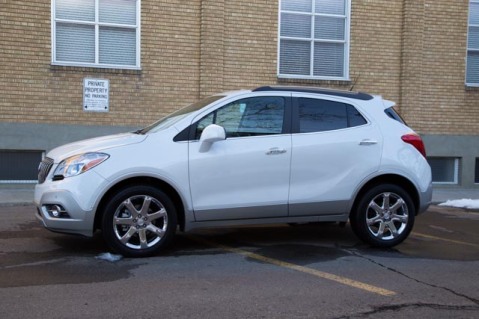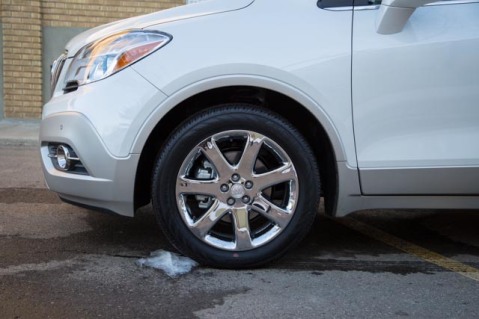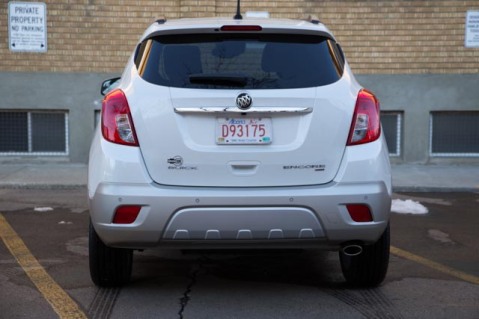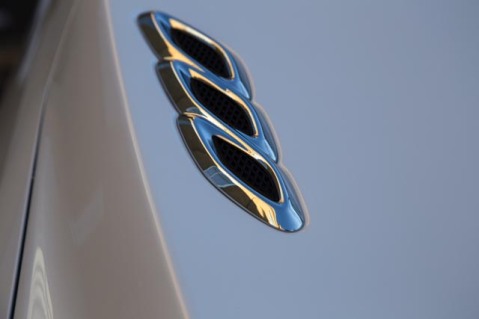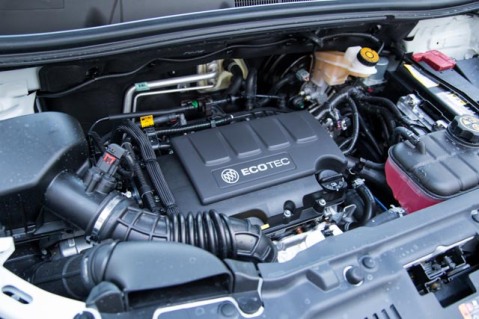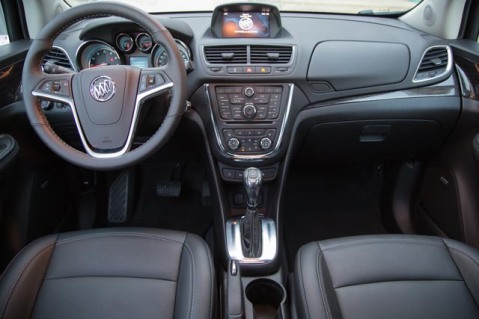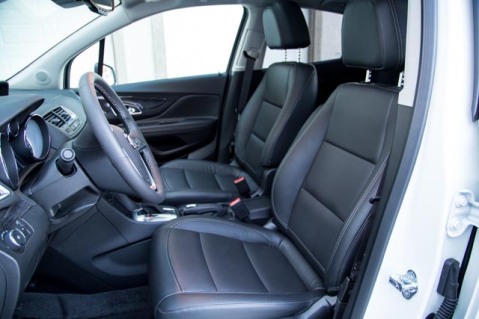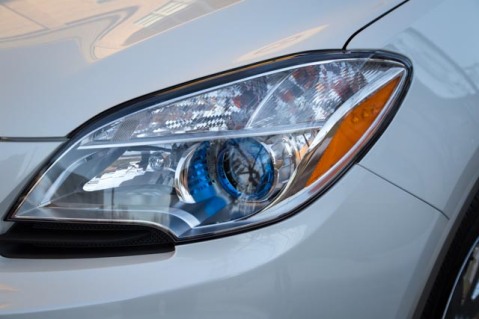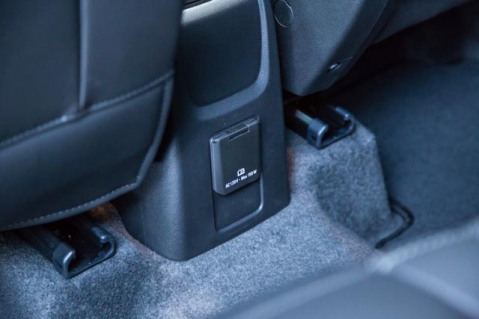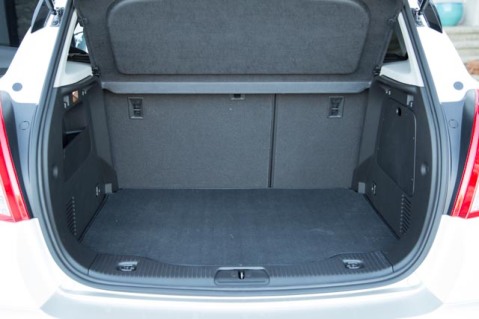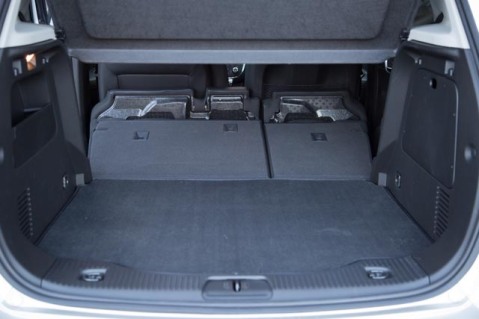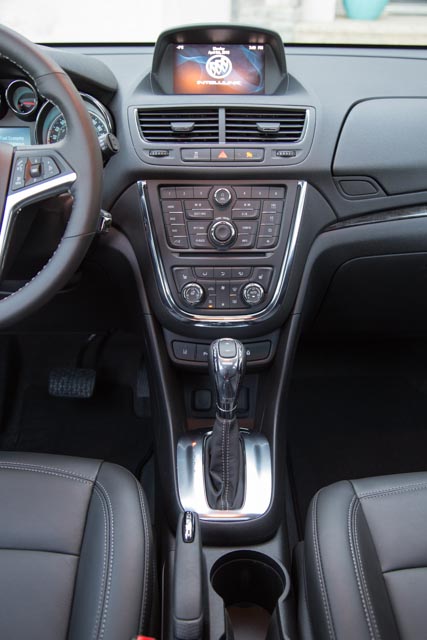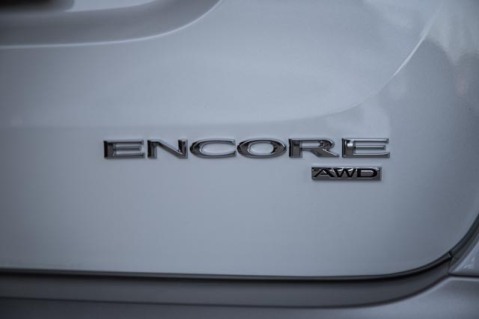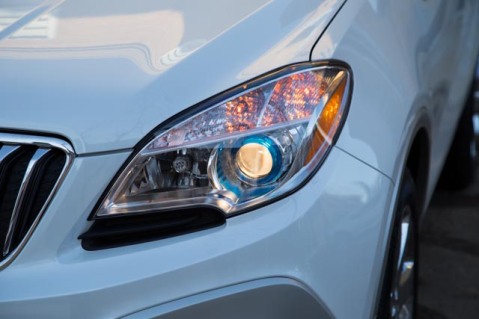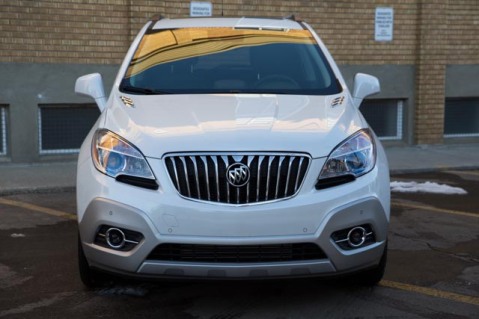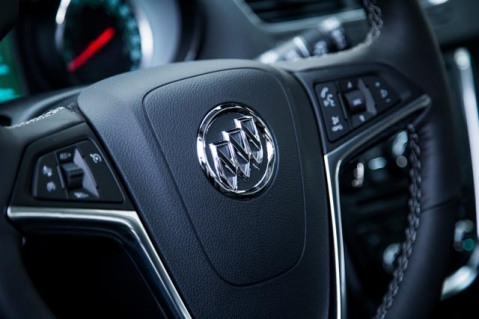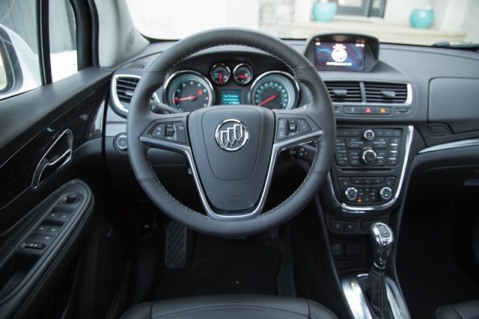2013 Buick Encore Premium AWD Review

A couple of months ago, I reviewed the Chevrolet Trax. I quite liked most of what I discovered. So when I got the opportunity to spend a week with its high-society cousin, the Encore, I was excited.
Exterior
In terms of styling, the Encore has the Trax handily beat. Its tidy proportions are sculpted, but not overstyled – I like how they integrate the very slightly flared fenders. It has very short overhangs, front and rear, and the beltline is quite high, angling up even higher as it makes its way to the back. The Buick chrome waterfall grille shows up here, but in my opinion, it’s the best application of it yet.
I really liked the shiny, polished 18″ rims and the 215/55-sized rubber that might look a bit skinny on another ride looks just right on this smaller vehicle. The headlights are massive units, and have interesting details. The blue corona rim around the projector looks cool, and the foglights below are very nicely done. Front and rear fascias have “skidplates” on the bottom, giving it a hint of ruggedness – unnecessary, of course, but it’s not overdone. The tail lights sweep forward, blending into the character crease that makes its way back, following the lines of the door handles.
If there is an angle that could be called the Encore’s ugly side, I’d have to say it’s the rear profile. It’s a bit of a hunchback, and quite a narrow vehicle, giving it the appearance as though it’s nervous and is clenching its butt-cheeks together. But it’s not a terrible angle, and the rest of it appealed to anyone who came over to check it out and ask questions. They finished the back off with a classy oval exhaust tip.
I had a number of people (women and men alike) say that the Encore was probably styled for the female demographic. But everyone said they liked it – and I agree wholeheartedly. It’s a smart, stylish design that throws some elegance and some fun into the mix. It’s just a shame that they’re still hanging on to those silly faux portholes on the hood. Silly, I say!
Under the Hood
The diminutive engine that greets you when you pop the hood might remind you of a mouse peeking out of it’s hole in the wall. It’s that small. It looks like you could get another engine in there.
So what is it then, this mouse? It’s a 1.4-litre turbocharged 4-cylinder. The numbers aren’t astounding, but that’s not the whole story. It puts out 138 horsepower between 4900 and 6000 RPM, and makes its peak torque available to you at a low 1850 RPM.
The power makes its way through a 6-speed automatic, to all four wheels using a front-wheel-drive-based all-wheel-drive system.
Fuel economy is rated at 8.9 L/100 km (26 mpg) in the city and 6.7 L/100 km (35 mpg) on the highway. My week with it was typical for my reviews. Daily commuting, occasional heavy foot, no effort to conserve fuel and a few freeway/highway sprints. I averaged 10.3 L/100 km (23 mpg) which isn’t amazing for a small vehicle, but it’s actually pretty good. The fuel tank holds 53 litres and the Encore doesn’t require premium fuel.
Interior/Tech/Convenience
The interior is crafted out of very nice materials. I’ve come to expect upper-crust interiors from Buicks, and this one didn’t disappoint. Fit and finish was pretty good, and you’ll find soft-touch plastics everywhere. Dash, door panels, you name it. This particular one had the dark interior, which gets a bit sombre. I’ve seen the lighter interior option in pictures, and it’s lovely.
The heated leather seats are very comfortable, and offer a surprising amount of bolstering. That’s a good thing! They are power-adjustable fore and aft, as well as for the lumbar support. The recline function, however, needs to be done manually. This had me scratching my head in the Trax as well. The driver’s side seat has a 2-position memory setting and a flip-down center armrest. Too bad, so sad for the passenger if they want to rest their left arm anywhere.
The manually-adjustable heated steering wheel is decent. It has controls for cruise, media, handsfree and phone functions. The Encore is started with a key – no push-button starter here. The key fob has remote lock/unlock functions, as well as a remote starter. I liked that last feature.
Ahead of you is a bin with the standard Buick gauges. I really like them, because they are easy to read and classy. The markings on the bezels make them look like a nice watch, rather than an automobile gauge. Between the two main gauges is GM’s standard driver information screen. It’s not pretty, with its crunchy green text and graphics, but functionally I have no complaints. It allows you to switch between timer, average fuel economy, fuel range, two trip meters and it always shows your gear selection, a compass and your odometer at the bottom.
The center of the dash has a hooded screen sticking out of it, running Buick’s Intellilink system. Although it works fine, the interface is starting to show its age. I much prefer the simpler, boiled-down approach I found in the Chevy Trax – the MyLink system is one of the simplest, most-effective I’ve used in a long time, and I hope it makes its way through GM’s products. Anyway, the screen here handles your media (sources are AM, FM, satellite radio, CD, auxiliary, USB and Bluetooth streaming), your phone functions, the navigation system, some vehicle settings and the back-up camera. You navigate around it with a rotary dial, and by pushing the ring around it as an ENTER button. It takes a couple of tries, but it ends up making sense. Of course, you can also operate it through voice command, if you want to. Good luck with that. The screen is too far away and therefore there is no touch-screen function.
The BOSE system sounds really good, by the way.
On the center stack, below the screen on the dash, is an ungainly sea of same-coloured buttons. It would be impossible to use any of them without taking your eyes off the road – thankfully, you wouldn’t need to use them very often. Underneath that is a dual-zone automatic climate control system.
There isn’t really a center console, just a collection of things between the seats. Here you’ll find the gear selector, a traditional parking brake lever, two cupholders.
Overhead you’ll find a small powered tilt/slide sunroof.
Driver assistance tech is quite complete. You get lane-departure warning system, forward collision alerts and front and rear parking distance sensors with audible alerts (augmented by the back-up camera of course). The rain-sensing automatic wipers are a nice touch as well.
Rear Seats
There are three rear seats – each has a seatbelt, and the outside two seats have headrests. The two outboard positions are very comfortable, but the middle one is very tight and barely usable for an adult. The fact that there is barely any foot room behind the center console doesn’t help either. The head room back there is good for my 5’10” frame, and the leg room is certainly acceptable for this size and class of vehicle.
There’s not a lot going on in terms of convenience. You get a 120V household plug at the back of the center console (a fantastic feature that should be standard in every vehicle!) and two seatback pockets – one mesh, one solid fabric. The door bins back there are shallow, but offer a bit of extra space. The middle seatback folds down to become an armrest, and it has two cupholders in it.
If you’re throwing kids in the back seats, and by throwing I mean gently placing, you’ll find good space for two of them. There are two sets of LATCH connectors for their seats. Our three kids actually felt cramped width-wise – it’s just not a very wide vehicle. But two of them would find it very roomy.
Storage
The standard glove box is a good size, and you also get an upper glove compartment in the dash. It is totally rubberized, and although it’s not huge, I find it a very useful space.
I liked the angled, rubberized open bin under the center stack. It’s perfect to drop things like a smart phone into, and it also has 12V, auxiliary and USB plugs.
The front door bins are quite useable, with little added sub-bins under the door grabs. The left underside of dash houses a pop-out bin and at the back of the center “console” there’s a scrolling lid, covering a small, rubberized storage bin.
The cargo area is quite big at 533 litres with the rear seats in use. Fold the seats down (they split 60/40) and you’re looking at a 1371 litre space, which affords you great utility. I found the load floor to be at a perfect height in terms of convenience, and there is a small storage bin on either side of the trunk as well.
The trunk space is covered by a removable hard tonneau cover that swings up and out of the way with the tail gate. This also adds a parcel shelf if you need every cubic foot available on a road trip or something like that.
The Drive
I really liked the high driving position. It affords you an excellent view of the road ahead and around you. With that said, those rear flanks sweep up and join with those massive rear pillars, making it difficult to shoulder-check – especially on the passenger side.
It’s not a fast vehicle, that much is clear from the moment you start driving it. But that’s not the point. The driving experience is a lively one, and the chassis is dynamic enough to make it fun enough.
The power builds in a very linear manner, but it never feels as though it has a lot of jam under the hood. With that said, it’s plenty for everyday driving. You probably don’t want to pull out of a side street in front of a speeding car and passing someone on the highway requires a bit of planning and a few seconds longer than more vehicles need. But during the week I had it, I rarely wanted for more power.
The transmission is relatively smooth, although there is often a split-second of hesitation between shifts. The smoothness isn’t interrupted, but the power feels as though it is, albeit very, very briefly. I’m not sure if software retards the ignition momentarily between shifts, or what the story is. It’s not intrusive, and you get used to it after a couple of drives. The transmission seems to be mostly interested in saving fuel, and it hunts for higher gears right away. When you step on it to pass, it takes a couple of seconds to downshift to the right gear. You can also manually shift gears, using the top-mounted rocker on the gear selector. It’s not a great solution, but it’s better than the ones in some other vehicles. Namely the thumb-toggles on the left side of the gear selector which is my most disliked manual shifting option. Shifts here are pretty slow, and therefore I found little use for manual shifting. Let the auto-box do its job and you’ll be set.
The ride is firm, but in a sporty way, not a bad way. It remains comfortable and well-controlled. I thought the handling was quite good as well. The Encore actually has just under 8″ of ground clearance, which is respectable. That also raises the center of gravity, and you end up with quite a bit of body lean around corners. But it’s not alarming, and it hangs on tenaciously when you throw it into curves. It obviously prefers the straights, but it will do just fine in the twists too, considering it’s a small crossover.
The Encore weighs 3254 pounds in this trim. That makes it a relative feather-weight for an all-wheel drive crossover, and it’s certainly light enough to run around town with ease. It never feels heavy or bloated.
There is some minor road noise, but overall, it’s a quiet vehicle. Drivetrain and wind noise levels are very good, unless you’re really stepping on the gas. In that case, you’ll get a nice little snarl from under the hood, and then things get a bit buzzy over about 4000 RPM. But it’s not something that’s really intrusive.
The brakes are fine – nothing too powerful, but they always worked well. The all-wheel drive is slip-and-grip so you’ll always feel the front end trying to grab before it digs its heels in. But for most folks, it’s perfectly effective, and it did as good of a job on our crappy, snowy Edmonton streets as it did on our crappy dry, pot-holed Edmonton streets.
This is probably clear to most readers, but if you’re still wondering, towing is not recommended with the Encore.
Nitpicks
Although the Encore comes well-equipped, if I had choices here, I’d very happily forgo something like lane-departure warning in exchange for a power liftgate. A power liftgate is a pretty big deal to many buyers, especially on a crossover. Especially in the premium segment.
I didn’t enjoy the extra step of having to tumble the rear seat bottoms forward before you can fold the seatbacks flat. It’s not a big deal, but it’s pretty unusual these days. A small annoyance.
The Verdict
I loved almost everything about the Encore. I really enjoyed the stylish exterior, and the high-quality interior. I felt the performance was fine for normal, everyday driving, and for a family of four, this vehicle would cover just about every need and want. There’s plenty of driver tech, plenty of comfort and plenty of luxury.
WAF (Wife Acceptance Factor) was very, very high. She absolutely loved the styling, saying it was nearly perfect for a small crossover. She liked the way it drove, appreciating that it never felt big while on the road or making its way around a parking lot. She also commented on the cargo capacity, noting that she was able to easily fit a Saturday’s shopping in – which is quite a feat, I assure you. She did miss the lack of a power liftgate though.
Pricing
2013 Buick Encore Premium
Base price (of specific trim): $34,455
Options: $1100 express open sunroof; $995 white pearl tri-coat; $995 navigation/audio upgrade; $100 oil pan heater
Freight: $1550
A/C tax: $100
Price as tested: $39,295
Blog provided with permission from Tom Sedens, a local automotive blogger in Edmonton, Alberta, and member of the Automobile Journalists Association of Canada (AJAC). For more vehicle reviews, visit wildsau.ca.
Discover the Drive Wheaton Difference!

We are proud to announce our partnership with Wheaton Honda, Sun Toyota on Whyte, and McClellan Wheaton Chevrolet Buick GMC Cadillac to launch our brand new GROUP site, Drive Wheaton!
With new vehicle inventory from 8 major manufacturer lines and a combined used vehicle inventory with over 350 vehicles to choose from, we are confident that we can whatever is needed to best serve you, anywhere in northern Alberta:
Don Wheaton Video: 2013 GMC Sierra Denali
The Sierra Denali puts a premium on your comfort, convenience and control with refined features such as high-quality leather-appointed seating, soft-touch materials, chrome and wood-grain details and the latest infotainment technology. Here’s our New Vehicle Sales manager, Tim Butler, and the 2013 GMC Sierra Denali:
Video courtesy of Strathcom Media
2013 GMC Acadia Denali AWD Review

The Acadia is GMC’s edition of the non-identical triplet GM SUVs.
The others are Chevrolet’s Traverse and Buick’s Enclave, and the Acadia slots in between them in terms of price and cachet.
Pricing: 2013 GMC Acadia Denali AWD
Base price (of specific trim): $55,355
Options: $575 20″ chrome wheels; $515 Crystal Red tintcoat; $3,250 navigation and rear seat entertainment system
Freight: $1,500
A/C tax: $100
Price as tested: $61,295
Exterior
The Acadia’s styling has been updated slightly, but remains aligned to the original. I’ve always felt the Acadia was the most handsome of the triplets. The Denali trim steps it up a notch too.
It’s a pretty chunky SUV with substantial front and rear overhangs. The grille, headlights and foglights are all integrated cleanly. That Denali grille doesn’t look like it’s messing around, and the cool bracketed LED running lights got a lot of second looks.
The rear side glass gets the wrap-around look, a la Ford Explorer. The fenders flare out a bit, and there are new integrated exhaust tips that blend into the rear end. There’s plenty of chrome, especially on the front and rear ends, to remind you that this is a Denali. For the most part, it’s done in a classy way, although the bottom of the tail gets a bit blingy for my taste. It’s a good-looking SUV, but it is a bulky one.
A final note – the Crystal Red tintcoat looks spectacular and simply glows when it’s clean. A number of people commented very positively on this color, and I quite liked it too.
Under the Hood
GM’s 3.6-litre direct-injection V6 puts out 288 horsepower at a soaring 6300 RPM. Thankfully the torque that we’re after in North America (270 lb.ft of it) is accessible at 3400 RPM.
The fuel economy is rated at 13 L/100 km in the city and 8.6 L/100 km on the highway.
Sadly, my average for the week came in at 15 L/100 km. This combined some city driving, much of it through slush and heavy, fresh snow and so it shouldn’t be that surprising for this class of vehicle. The unfortunate thing is it also included a road trip to Calgary with our family. I actually made an effort to drive economically, which I usually don’t do. I wonder what I would have averaged if I’d driven normally, which included the occasional heavy foot.
Interior/Tech/Convenience
The interior is clad in very nice materials – pretty much everything around the cabin is soft-touch plastic, or cushy upholstered and stitched material. All in all, I liked the colours and the contrasting tones were pleasing. The wood trim came across as a bit contrived and fake-looking.
The leather seats are very comfortable and nice to look at, but offer basically no bolstering whatsoever. They’re heated and power-adjustable. I found the cabin to be very spacious and at 5’10”, there was plenty of headroom for me.
In front of you, you’ll find a decently designed steering wheel, with buttons for cruise control, phone, media and handsfree functions. Behind it are two simple red-lit gauges with a driver information screen between them. It comes with a nasty dot-matrix font display – it works fine, but it’s not nice to look at.
At the top of the center stack sits a touchscreen handling media, phone and vehicle setting functions. It’s not the most intuitive system, but it works fine. I’m starting to prefer a more simplistic approach that I’ve seen in something like the Chevy Trax.
Below the screen is the tri-zone automatic climate control system. Dual-zone up front, and controls for the rear zone. Nice! At the bottom of the stack is a 12V plug and a storage slot – sadly, it’s basically useless because it’s only about an inch and a half deep.
The center console is home to the shift lever and two cupholders. Behind that is a scrolling cover – slide it back and you’ll find two organizer trays and below them, a carpeted bin with another 12V plug. Finally, there’s a sliding armrest with a shallow storage tray under the lid.
Overhead, you’ll find a 3 position HomeLink garage door openers and a lovely dual sunroof – the front one tilts and slides and both have manually retractable sunshades.
I really liked the heads-up display in the Acadia. It’s adjustable for brightness and height on your windshield, and allows you to toggle what it displays. You can see a digital speedometer, a speedo and a digital tachometer, or what’s playing on your media system. This model also has a blind-spot monitoring system, which shows up as an orange symbol that will glow in your side-view mirror when someone is in your blind-spot. Even if they’re a couple of lanes over.
Second Row
The second row has two bucket seats – they are very comfortable, and are adjustable fore and aft, and recline as well. I appreciated the center armrests that can flip up and out of the way. There is ample head and leg room in the second row, and it feels even more spacious because of the light from the second sunroof above.
The seats have enough space between them for someone to get to the third row. Alternatively, they slide and fold forward easily to make third row access even better. We also found the space between the seats useful for significantly more stuff during road trips.
There’s plenty of comfort and convenience here too – there’s a rear climate control panel at back of the center console (feeding excellent ceiling-ducted vents for both rear rows – like a minivan), a separate audio system controls and two headphone plugs, a 12V and a 120V household plug, and a ceiling-mounted DVD-based rear entertainment system.
A couple of seatback map pockets, decent door bins and a convenient cupholder in the door’s armrest all help put things in their place.
Each of the second row seats has a LATCH anchor for kids’ seats and the doors open wide for easy access.
Third Row
The third row has three seats, three seatbelts and headrests for the two outboard positions. Although the seats are thinner and somewhat harded, they actually remain pretty comfortable. Surprisingly, I had enough headroom back there too. Legroom is at a premium, but adults could fit back there which is both impressive and unusual. The biggest space issue was the room for feet, which is limited because of the second row seat tracks. Even third row passengers are blessed with cupholders, storage bins on each side and separate reading lights.
Storage
Main cabin storage consists of a lidded bin on the dash, containing the USB plug, somewhat useless front door bins and a large glove compartment.
The trunk space has quite usable room even when the third row is in use – 691 litres. We took the Acadia on a short road trip to Calgary and back with three adults and three kids and were fine. There are great tie-downs, a 12V plug and a significant storage compartment (which is the full width of the trunk) under the floor.
Of course, the third row folds flat (in a 60/40 split) to make an almost ridiculous 1991 litre cargo space. There’s a power liftgate – you can open it from the dash, your key fob and from inside or outside the trunk lid.
Detail
I found something here in the Acadia that I haven’t seen in any other vehicle to date. Rear audio controls. Nope, not the ones that are at the back of the center console that you can control from the second row. No, these ones are in the trunk! They allow you to choose your music source, change tracks or stations and control the volume. Sprechen Sie tailgate party?! Not sure I’d ever use this function, but football fans or campers would love it!
The Drive
The Acadia does the driving thing well. Considering its great mass (well over 4800 pounds), the handling is very secure and competent and it feels less top-heavy than some other large SUVs. It has a great ride in the city and on the highway.
It felt very torquey off the off the line – GMC got the low-end gearing and throttle response right here. Is it a fast vehicle? Not particularly, no – but it never feels slow around town. Even on the highway, once it shifts into the correct gear for passing, it does a good job moving its bulk in the right direction.
I also appreciated that it was a quiet ride – road, wind and drivetrain noise was controlled very well in all situations.
The transmission is smooth, and for the most part, does its job imperceptibly. You can shift it manually, using a thumb toggle on the gear selector. I hate these manual shifting systems, and on vehicles like this, it tends to make more sense to allow the slushbox to do its own job.
The Acadia is a front-wheel drive based vehicle, and you can tell when you’re in the snow – it plows a bit before the rear tires get some torque. Of course, for most driving, it does a great job, but if you’re trying to have some fun in the white stuff, it’ll always start with plenty of understeer. That’s not a knock on the vehicle, and to be expected in this class.
I found the brakes to be powerful enough effective, and the visibility out of the vehicle is decent. The view out of the back is a bit constricted and it’s further hampered by the headrests.
The Verdict
Although the Acadia comes in at a significantly higher price than some of the three-row large cross-over competition (like say the Nissan Pathfinder or the Toyota Highlander), the similarly-equipped Chevy Traverse’s price (which would be a more base model like the 2LT) would be closer. Neither of the competitive base models has a sunroof or a rear-seat entertainment system. Personally, I’d never consider the latter – buy each kid an iPad mini and they’ll be happier, you’ll get much more utility out of them and save money.
WAF (Wife Acceptance Factor) was exceptionally high. She absolutely loved it. She said it felt very secure on the road, especially around corners, and she enjoyed the driving position. She also felt that everything inside made sense to her, except that they put the rear wiper controls on the dash – I’d have to agree with her there.
Overall, the Acadia really impressed me. It felt very well built. The materials and appointments inside are nice, and the details are thoughtful especially when you compare it to an aging vehicle like a Toyota Highlander.
The vehicle works well, especially for larger families that would need the space in the city on a daily basis, and also need to stretch their legs on the highway occasionally. I found it did a good job of getting us around, moving the way we wanted it to, looking decent and consistently surprising us with well thought out touches. The Acadia is a vehicle I would happily own. The only thing that would give me pause would be the fuel economy and the slightly elevated price versus the competition.
Blog provided with permission from Tom Sedens, a local automotive blogger in Edmonton, Alberta, and member of the Automobile Journalists Association of Canada (AJAC). For more vehicle reviews, visit wildsau.ca.
